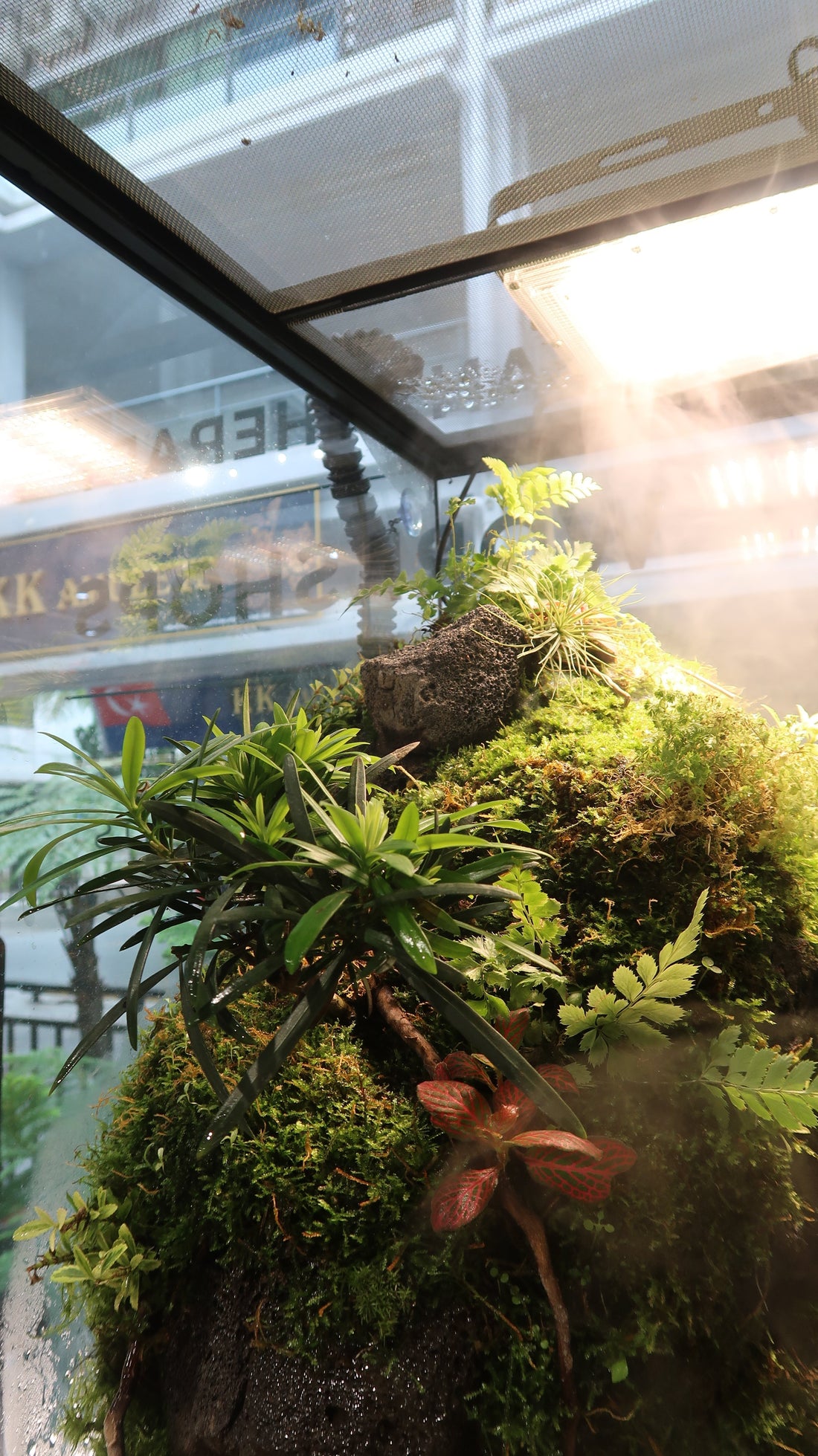
Open vs Closed Paludariums, what are the differences?
Both open and closed paludariums are beautiful ways to bring nature into your home, but they have distinct setups and maintenance needs.
Here's a breakdown of the difference:
| Closed | Open | |
|---|---|---|
| Environment |
Isolated environment which encourage inter-circulation within the container involves water cycle and minimal air exchange with surroundings. |
Exposed environment which a lot of frequent air exchange and rapid evaporation. |
| Water Cycle |
Recirculated through evaporation and condensation. That creates a self-sustaining water cycle which helps to maintain moisture levels without needing frequent water changes. |
Doesn’t recirculate as much! You would need to top up the water from time to time and change water more frequent. |
| Humidity & Plants |
High humidity is a key factor for a closed paludarium. Tropical plants, ferns and carnivorous plants thrive here. |
Lower in humidity making it better suited for plants that don’t require constant moisture, like certain succulents and air plants. |
| Maintenance |
Easier in terms of humidity control, but it can be harder to manage air circulation. Not to have too much mold or algae growth, and sometimes you might need to open it for some time for airflow. |
Requires more attention to the water levels and humidity, but they allow for better air circulation. Easier to maintain in terms of airflow and can support a wider variety of plants and animals. However, you still need to make sure the plants don't dry out! |
Don't started to feel overwhelmed yet!
Ask yourself which one to choose?
- If you're into low-maintenance, high-humidity plants or you want to create a lush, rainforest-like environment, then closed paludarium is a great choice.
- If you prefer a more diverse ecosystem with a mix of terrestrial and aquatic life, or you don’t mind to upkeep with water levels, then open paludarium is for you!
Here are a few practical tips:
1. Start simple
Instead of jumping into a complex setup, consider starting with a smaller and low-maintenance paludarium. A basic, open setup with just a few plants and a simple water feature can help you get a feel for how things work without too much stress.
- Closed paludarium: You can start with just a small section of tropical plants that thrive in high humidity (like mosses or ferns). You don’t need a complicated ecosystem right away.
- Open paludarium: Choose plants that are more forgiving and adaptable to varied humidity levels. Succulents or air plants are great starting points!
2. Airflow management made easy
Airflow is important, but it doesn't have to be super complicated. Here are a few ways to simplify airflow management:
- Closed paludarium: You don't necessarily need a fan for airflow, especially if you're keeping the setup simple. Opening the lid for a few minutes once a day can be enough to give it some fresh air and prevent mold.
- Open paludarium: Fans can be helpful for circulating air but they don't need to be on all the time. Even just having the top open for a few hours each day can do the trick. If you want more control, a small, low-power fan can be used intermittently (just keep it on a timer if you’re worried about overdoing it).
3. Keep it low-tech
A lot of people get overwhelmed thinking they need fancy equipment. The truth is, most paludariums can thrive with basic tools. To keep things low-tech:
- Humidity: You don’t need a fancy humidity monitor right away (you can just use your eyes and feel the air!). If your plants look happy and the water’s not evaporating too quickly, you're probably in the right zone. A simple misting bottle can help to maintain moisture.
- Watering: For an open paludarium, using misting device can make maintenance easier. For closed paludarium, just opening the lid to let air circulate a couple of times a week can be enough.
4. Simplify the setup
You don’t need to fill the paludarium with tons of plants and critters all at once. Focus on one or two key species (plants or animals) that are easy to care for, and gradually build it from there.
- For example, start with low-maintenance plants (like moss, pothos or ivy) that don't need intense humidity or specific light. This allows you to get a feel for the process before you add in more demanding species.
5. Take it one step at a time
Rather than trying to get everything perfect from the start, give yourself permission to experiment and learn as you go. Start with the basics and if you notice any issues, you can tweak the setup over time.



